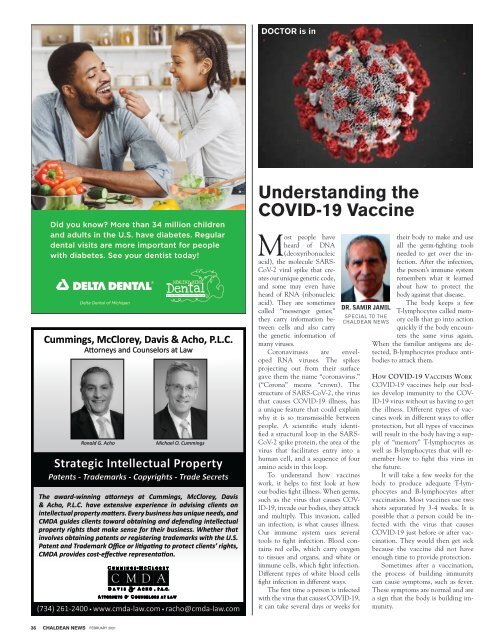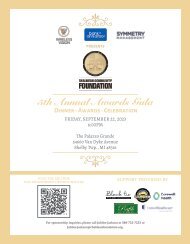FEBRUARY 2021
Create successful ePaper yourself
Turn your PDF publications into a flip-book with our unique Google optimized e-Paper software.
DOCTOR is in<br />
Did you know? More than 34 million children<br />
and adults in the U.S. have diabetes. Regular<br />
dental visits are more important for people<br />
with diabetes. See your dentist today!<br />
Delta Dental of Michigan<br />
A TTORNEYS & C O UNSELORS AT LAW<br />
Understanding the<br />
COVID-19 Vaccine<br />
Most people have<br />
heard of DNA<br />
(deoxyribonucleic<br />
acid), the molecule SARS-<br />
CoV-2 viral spike that creates<br />
our unique genetic code,<br />
and some may even have<br />
heard of RNA (ribonucleic<br />
acid). They are sometimes<br />
called “messenger genes;”<br />
they carry information between<br />
cells and also carry<br />
the genetic information of<br />
many viruses.<br />
Coronaviruses are enveloped<br />
RNA viruses. The spikes<br />
projecting out from their surface<br />
gave them the name “coronavirus.”<br />
(“Corona” means “crown). The<br />
structure of SARS-CoV-2, the virus<br />
that causes COVID-19 illness, has<br />
a unique feature that could explain<br />
why it is so transmissible between<br />
people. A scientific study identified<br />
a structural loop in the SARS-<br />
CoV-2 spike protein, the area of the<br />
virus that facilitates entry into a<br />
human cell, and a sequence of four<br />
amino acids in this loop.<br />
To understand how vaccines<br />
work, it helps to first look at how<br />
our bodies fight illness. When germs,<br />
such as the virus that causes COV-<br />
ID-19, invade our bodies, they attack<br />
and multiply. This invasion, called<br />
an infection, is what causes illness.<br />
Our immune system uses several<br />
tools to fight infection. Blood contains<br />
red cells, which carry oxygen<br />
to tissues and organs, and white or<br />
immune cells, which fight infection.<br />
Different types of white blood cells<br />
fight infection in different ways.<br />
The first time a person is infected<br />
with the virus that causes COVID-19,<br />
it can take several days or weeks for<br />
DR. SAMIR JAMIL<br />
SPECIAL TO THE<br />
CHALDEAN NEWS<br />
their body to make and use<br />
all the germ-fighting tools<br />
needed to get over the infection.<br />
After the infection,<br />
the person’s immune system<br />
remembers what it learned<br />
about how to protect the<br />
body against that disease.<br />
The body keeps a few<br />
T-lymphocytes called memory<br />
cells that go into action<br />
quickly if the body encounters<br />
the same virus again.<br />
When the familiar antigens are detected,<br />
B-lymphocytes produce antibodies<br />
to attack them.<br />
How COVID-19 Vaccines Work<br />
COVID-19 vaccines help our bodies<br />
develop immunity to the COV-<br />
ID-19 virus without us having to get<br />
the illness. Different types of vaccines<br />
work in different ways to offer<br />
protection, but all types of vaccines<br />
will result in the body having a supply<br />
of “memory” T-lymphocytes as<br />
well as B-lymphocytes that will remember<br />
how to fight this virus in<br />
the future.<br />
It will take a few weeks for the<br />
body to produce adequate T-lymphocytes<br />
and B-lymphocytes after<br />
vaccination. Most vaccines use two<br />
shots separated by 3-4 weeks. It is<br />
possible that a person could be infected<br />
with the virus that causes<br />
COVID-19 just before or after vaccination.<br />
They would then get sick<br />
because the vaccine did not have<br />
enough time to provide protection.<br />
Sometimes after a vaccination,<br />
the process of building immunity<br />
can cause symptoms, such as fever.<br />
These symptoms are normal and are<br />
a sign that the body is building immunity.<br />
36 CHALDEAN NEWS <strong>FEBRUARY</strong> <strong>2021</strong>

















